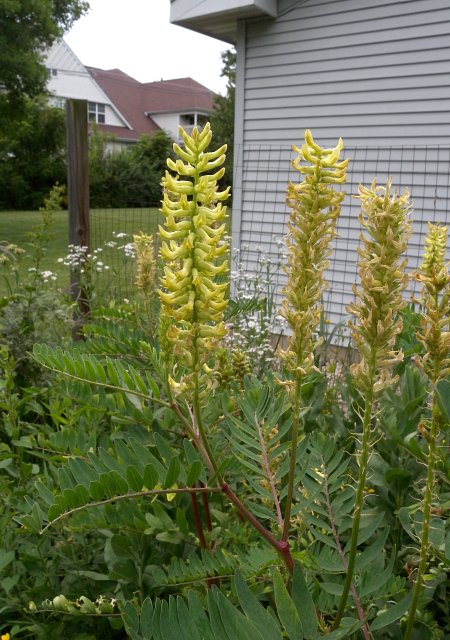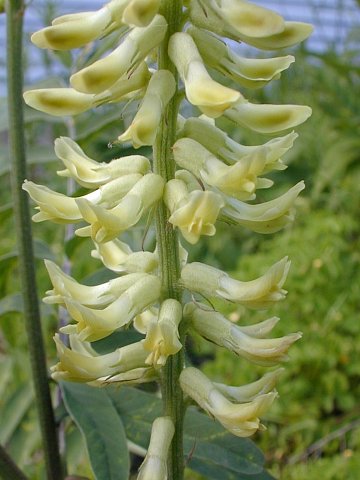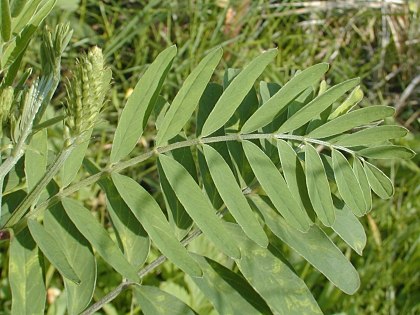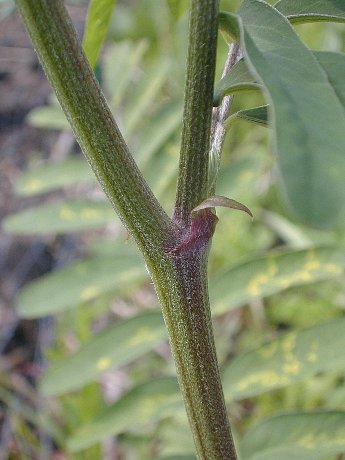Description: This perennial plant is 1½–3½' tall, branching occasionally. The ridged stems are pubescent. The alternate compound leaves are odd pinnate, and 5-9" long, with about 21-31 leaflets. The oblong leaflets are about 1½" long and 3/8" across, with smooth edges. From the upper axils of the compound leaves there occasionally develops a whorled raceme of flowers from a stout stalk. A raceme (including the stalk) is usually about 1-2" longer than the compound leaves subtending it, or about 7-11" long.

A typical raceme is crowded with about 75 creamy flowers, which may have yellow or green tints. Each flower is about ¾" long and tubular-shaped, although jutting slightly upward toward the outer tip. It consists of five petals, including a curved upper hood, a lower keel, and close-fitting side petals. The blooming period occurs during the summer and lasts about 2-3 months. There is no noticeable floral scent. The flowers are replaced by stout oval pods with long pointed tips, which are held nearly erect on the stalk. The root system consists of a taproot.

Cultivation:
The
preference is full or partial sun and mesic conditions. Canada
Milkvetch grows well on most kinds of soil, and probably fixes some
nitrogen. It's a robust plant, although the foliage sometimes turns
prematurely yellow. This plant has a tendency to sprawl, unless it
receives support from adjacent vegetation.
Range & Habitat:
The native Canada Milkvetch occurs occasionally in the northern half of
Illinois,
but it is rather uncommon in most areas of southern Illinois (see Distribution
Map). Habitats include moist to slightly dry black soil
prairies, sand prairies, typical and sandy savannas, thickets and
woodland borders, moist meadows near rivers, and abandoned fields.

Faunal Associations: Primarily bumblebees visit the flowers for nectar. Other long-tongued bee visitors include honeybees and Megachile spp. (Large Leaf-Cutting Bees). Insects with shorter mouthparts have trouble reaching the nectar, nor is the pollen easy to access. Unlike many milkvetches of the Western states, the foliage of Canada Milkvetch is non-toxic and palatable to mammalian herbivores, including deer, groundhogs, rabbits, and livestock. This plant may be difficult to establish where these animals occur in abundance. The seeds may be eaten occasionally by the Wild Turkey and other upland gamebirds, as well as small rodents, such as the Thirteen-Lined Ground Squirrel; however, such observations are confined largely to the Western states, where Astragalus spp. are more abundant.

Photographic
Location: The wildflower garden of the webmaster in
Urbana, Illinois.
Comments:
There are
very few Astragalus spp. that occur in Illinois.
Canada Milkvetch has a distinctive appearance on account of its size
(up to 3½' tall) and abundant creamy flowers (about 75 per raceme).
Some
pale-flowered vetches are superficially similar in appearance, such as Vicia
carolina (Carolina Vetch). However, vetches are vine-like
plants with tendrils, while Canada Milkvetch is a semi-erect plant
without tendrils (although it may clamber over adjacent vegetation,
nonetheless). Another difference is the inflorescence: the raceme of
Canada Milkvetch is whorled with about 75 flowers, while Vicia
spp. have one- or two-sided racemes with fewer flowers.